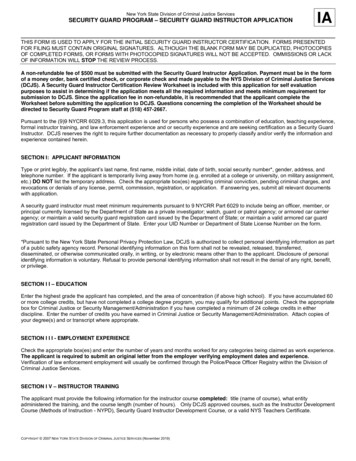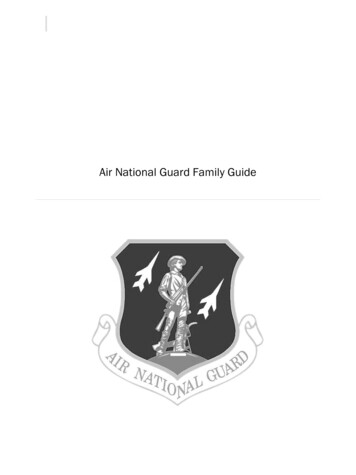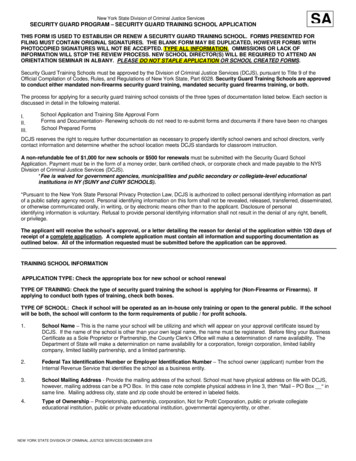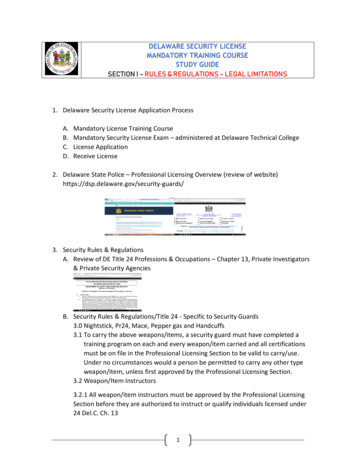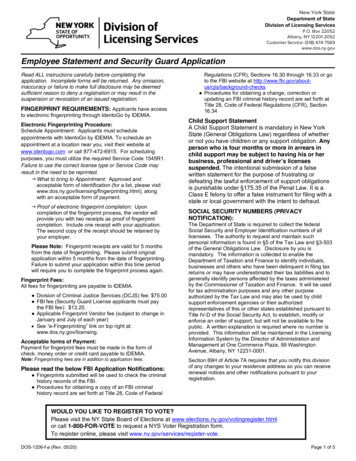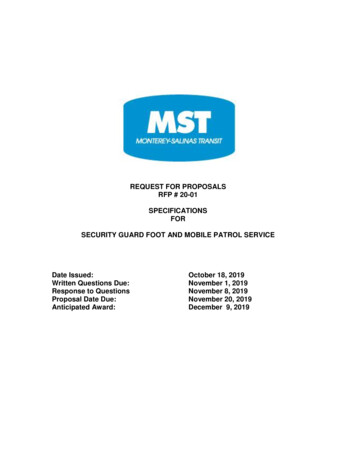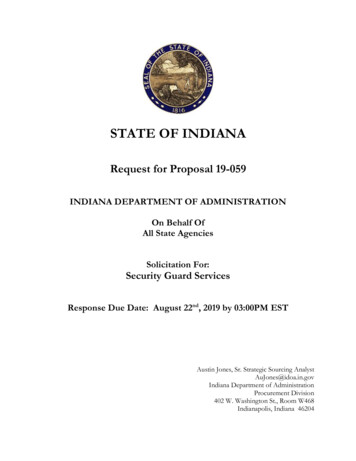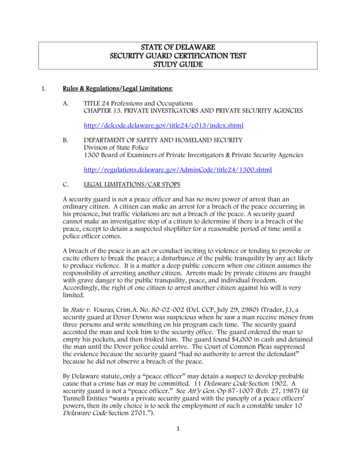
Transcription
STATE OF DELAWARESECURITY GUARD CERTIFICATION TESTSTUDY GUIDEI.Rules & Regulations/Legal Limitations:A.TITLE 24 Professions and OccupationsCHAPTER 13. PRIVATE INVESTIGATORS AND PRIVATE SECURITY ndex.shtmlB.DEPARTMENT OF SAFETY AND HOMELAND SECURITYDivision of State Police1300 Board of Examiners of Private Investigators & Private Security title24/1300.shtmlC.LEGAL LIMITATIONS/CAR STOPSA security guard is not a peace officer and has no more power of arrest than anordinary citizen. A citizen can make an arrest for a breach of the peace occurring inhis presence, but traffic violations are not a breach of the peace. A security guardcannot make an investigative stop of a citizen to determine if there is a breach of thepeace, except to detain a suspected shoplifter for a reasonable period of time until apolice officer comes.A breach of the peace is an act or conduct inciting to violence or tending to provoke orexcite others to break the peace; a disturbance of the public tranquility by any act likelyto produce violence. It is a matter a deep public concern when one citizen assumes theresponsibility of arresting another citizen. Arrests made by private citizens are fraughtwith grave danger to the public tranquility, peace, and individual freedom.Accordingly, the right of one citizen to arrest another citizen against his will is verylimited.In State v. Vouras, Crim.A. No. 80-02-002 (Del. CCP, July 29, 2980) (Trader, J.), asecurity guard at Dover Downs was suspicious when he saw a man receive money fromthree persons and write something on his program each time. The security guardaccosted the man and took him to the security office. The guard ordered the man toempty his pockets, and then frisked him. The guard found 4,000 in cash and detainedthe man until the Dover police could arrive. The Court of Common Pleas suppressedthe evidence because the security guard “had no authority to arrest the defendant”because he did not observe a breach of the peace.By Delaware statute, only a “peace officer” may detain a suspect to develop probablecause that a crime has or may be committed. 11 Delaware Code Section 1902. Asecurity guard is not a “peace officer.” See Att’y Gen. Op 87-1007 (Feb. 27, 1987) (ifTunnell Entities “wants a private security guard with the panoply of a peace officers’powers, then its only choice is to seek the employment of such a constable under 10Delaware Code Section 2701.”).1
Like most states, however, Delaware has a retail theft statute that authorizes storeowners and their employees or agents (including security guards) to briefly detainsomeone suspected of shoplifting. See 11 Delaware Code Section 840(c)(“A merchant, a store supervisor, agent or employee of the merchant 18 years of age orolder, who has probable cause for believing that a person has intentionally concealedunpurchased merchandise or has committed shoplifting as defined in subsection (a) ofthis section, may, for the purpose of summoning a law-enforcement officer, take theperson into custody and detain the person in a reasonable manner on the premises for areasonable time.”)For purposes of this statute, a security guard should have some basic training as to whatcomprises the elements of the crime of shoplifting, and what probable cause is (asopposed to reasonable suspicion).This document provided by the Board of Private Investigators and Private Security Agencies2
II.Use of Force/Verbal & Non-Verbal:The purpose of understanding the use of force, with regard to the duties of a security guard, isso various force options are known, and under which circumstances a certain level of forcemay be utilized. Because Delaware-certified security guards often carry different types ofweapons, it is important to become familiar with Delaware’s laws as they relate to use of force.An excessive use of force may be grounds for termination from the employee’s securitycompany, suspension or revocation of a security license, and/or criminal prosecution.Developing a thorough understanding of use of force laws is critical for the properperformance of duties as a security guard.Force OptionsI. Use of force is not a personal decision and it is not an emotional decision. It is dictated bystate law, and the circumstances surrounding the situation.II. As a security guard, you are authorized to protect yourself, protect others, and protect theproperty you are assigned to watch. Delaware Law specifies allowable use of force asfollows, under Title 11. The following sections are most relevant to the duties performedby security guards:A. Self-protection:§464B. Protection of others:§465C. Protection of property:§466III. The Federal Law Enforcement Training Center has published a “Force Continuum” withwhich all security officers should become familiar. (See chart on next page).IV. Often overlooked as a level within the force continuum, uniform and appearance oftendetermine if a particular security guard is worth challenging. Demeanor and attitude arealso factors that add to this dimension.A. Poor appearance and bad attitude: yields lack of respect, greater chance of beingchallenged by othersB. Sharp appearance and professional attitude: yields respect, less chance of beingchallenged by othersC. Security guards are paid to provide a service to a client, not to engage in personalbattles with disrespectful peopleV. Verbal challenges from others may be common, depending upon the environment.Knowing that security guards lack arrest powers, discourteous people may taunt securityguards and try to get them angry. Security guards show more professionalism andfortitude when they ignore the comments and simply remain professional.VI. A rule of thumb to remember-- the minimum amount of force necessary for the situation isthe expectation when employing force options. Security guards who use excessive forceare subject to employment penalties, criminal arrest, and/or civil penalties.3
4
Firearms (Title 24, Chapter 13)I. Security guard licenses for certified armed guards are commonly known as “red cards”II. Approved weapons for security guards in Delaware include the following handguns:A. Revolver or semi-automaticB. Double action or double action only (no single action)C. Authorized calibers—1. 9mm2. .3573. .384. .405. .45III. Initial certification of armed security guards requires the completion of an approved 40hour training course administered by a Board-approved certified firearms instructor. Thisrequirement may be waived by the Professional Licensing Section of the State Bureau ofIdentification upon review of the applicant’s professional credentials, training, and/orwork experience. Prior, recent law enforcement experience is taken into consideration.IV. Qualification after initial certification shall require the following:A. Three (3) qualifying shoots per calendar year, scheduled on at least two (2) separatedays (see III E for example)B. A minimum of 90 days must separate each qualifying shootC. Of the three required qualifying shoots, one (1) must be a “low-light” shootD. A score of 80% or above must be achieved at each qualifying shootE. Example annual shooting qualification: March 1st- day shoot at 0800 hrs. (8 a.m.),September 1st- day shoot at 1600 hrs. (4 p.m.) and a night shoot at 1930 hrs. (7:30p.m.)F. Individuals not meeting the minimum qualifications as set forth above may have theirfirearms license suspended until the requirements are met satisfactorilyV. In the case of any weapon carried, individuals must satisfactorily qualify with a weapon ofthe same make/model/caliber. Individuals are not authorized to carry a weapon of acaliber of which the individual has not qualified.VI. Any ammunition used must be “factory fresh” ammunition. Re-loads are not authorized.VII. Rifles and shotguns are not authorized for use by security guards, unless authorized by theGovernor of the State of Delaware, or the Superintendent of the State Police or his designee.Such authorization is only permitted under emergency circumstances as legally specified.VIII.A.B.C.Firearms carrying requirements for certified armed guards:Firearms may be carried while engaged in the performance of duties as a security guardFirearms may be carried while traveling directly to and from places of assignmentA distinctive uniform must be worn, including a patch which specifies the company bywhom the individual is employedD. The firearm must be in plain viewE. Carrying a concealed firearm in the performance of duties is NOT authorized5
Weapons other than Firearms (Title 24, Chapter 13)I. Security guards are authorized to carry the following weapons/items, if properly certifiedto do so:A. Nightstick or PR 24B. Mace or pepper sprayC. HandcuffsII. To be permitted to carry any of the aforementioned weapons/items, a training programmust be completed on EACH weapon carried, taught by a certified instructor representingthe manufacturer of the weapon/item.III. No items, other than those identified in paragraph I in this section, are authorized to becarried unless first approved by the Director of the Professional Licensing Section of theState Bureau of IdentificationContact and CoordinationI. When an actual or potential situation of force exists, assistance should be requested. Thereis no logic in trying to handle a situation of violence alone, especially when anothersecurity guard is available for assistance.II. Calling the police is a necessity when force is used against or by a security guard. Policewill investigate the incident and determine the appropriateness of the force threatened orused, and will make arrests as appropriate.6
III.Ethics:I.What it means to be a professionalA.Security guards are expected to act appropriately and present themselves asprofessionals. This includes being courteous and approachable toward bothyour employer and the public, and exhibiting a clean appearance.II.Values as guidelinesA.Security guards must be honest, reliable and trustworthyIII.Situational influencesA.The rules, regulations and laws that security guards must uphold apply equallyto all members of the public1.Consistency is mandatory and special favor must never be given,regardless of personal relationshipsB.All violations of laws and policies must be reported immediately to supervisorsIV.Standards of conductA.Security guards must conduct themselves with integrity and professionalismB.Security guards must follow the specific rules and policies regarding conductset-out by their employerV.Code of ethicsA.Private security guardAs a security officer I pledge:1.To ensure the safety and security of the personnel and property undermy protection;2.To perform duties with honesty and integrity and to uphold the highestmoral principles;3.To faithfully fulfill my duties and uphold the laws, policies andprocedures that protect the constitutional rights of others4.To discharge my duties truthfully, promptly and accurately within myresponsibility and without regard for friendship, prejudices or personaladvantages;5.To report any violation of law, rule or regulation to my supervisorswithout delay;6.To respect and hold confidential any privileged information of myemployer or client, except when those interests are contrary to law,regulation or this code of ethics;7.To respect, cooperate and assist with all responsible law enforcementagencies within their jurisdiction;8.To accept no gratuity, favor, compensation or commission without theknowledge and approval of my employer.IV. Emergency Services/First Responders:I.Handling emergency situationsA.Emergency situations often happen without warning and security guards mustbe prepared to respond. Although emergency situations vary in nature, asecurity guard’s response will be similar in most emergency situations1.Have a plan of action7
2.3.4.5.6.B.Know your locationKnow the location of first aid equipmentInsure that all first aid equipment is working Fully stocked first aid kits Radios FlashlightsBe aware of first aid procedures CPR certifiedKnow where the nearest escape route isIdentify the emergency; is it medical, weather-related, or is there a potentiallylife-threatening situation, then act accordinglyII.Medical emergenciesA.When to call EMS1.Be aware of the appropriate time to call 911, based on the situationIII.Intro to basic CPRA.Heart attack1.Common heart attack symptoms include pressure in the chest, shortnessof breath, nausea and dizziness or fainting2.When you encounter someone who may be having a heart attack, call9113.If the person experiencing the heart attack is unconscious, begin CPR If you have not received CPR training, doctors recommend onlyperforming chest compressions at the rate of approximately 100per minute The 911 dispatcher may be able to instruct proper CPRproceduresB.Choking1.When a person’s windpipe becomes blocked by food or small objects,they begin to chokeA.A choking person often gives the universal choking sign byclutching their throat with their handsB.Perform the Heimlich maneuver/abdominal thrusts until theblockage clears Stand with the choking victim in front of you Make a fist with your dominant hand and place it just above thenavel of the choking victim Use 5 quick, upward thrusts into the abdomen to try to force theblockage out Repeat if not dislodged2.Have another person call 911 while you perform the Heimlich maneuver3.Perform CPR with chest compressions if the person loses consciousnessC.Bleeding1.Apply gloves prior to assisting anyone who is bleeding2.Simple wounds such as minor scrapes or cuts require holding pressureonto the wound to stop the bleeding8
3.Elevate the wound if bleeding continuesIf bleeding continues after asserting pressure for more than 30minutes, seek medical attentionCall 911 for large, gaping wounds with flowing or spurting blood, andapply pressure onto the wound until medical assistance arrivesD.Skeletal injuriesFractures of bones require medical attention1.Call 9112.Immobilize the fractured area3.Apply ice packs to the area to limit swellingE.Drowning1.Call 9112.Perform CPR with chest compressionsF.Heat/cold related emergenciesA.Hypothermia results when a person’s body temperature falls to less than95 degrees Fahrenheit1.Symptoms of hypothermia include shivering, slow breathing,fatigue, slurred speech, cold skin, loss of coordination2.Call 9113.Move the person to a warm place but don’t apply direct heat4.Monitor the person’s breathing and perform CPR if breathingbecomes shallowB.Heat exhaustion is a condition that can be as minor as heat crampingand as severe as heatstroke1.Symptoms include heavy sweating, nausea, dizziness, headache,fatigue, and dark colored urine2.Move the person into a cool place, provide cool water andmonitor them closely3.Call 911 if they begin to have seizures or if they have a fever or104 degrees Fahrenheit or higherDisease transmission/Bloodborne pathogens1.Infectious microorganisms in human blood that cause disease are calledbloodborne pathogens HIV, Hepatitis B and C are included in these pathogens2.Exposure to bloodborne pathogens occurs when a person is stuck by acontaminated needle or other sharp object, or when tainted blood entersa person’s eyes, nose, mouth, or broken skin3.If you believe you have been exposed to a bloodborne pathogen, seekimmediate medical attention Flush the area with water and then use soap and water to clean itParental arrest with children1.Call Division of Family Services (DFS) At times, a person who acts criminally and is then detained by asecurity guard may have children with them. A security guard isexpected to act professionally and in a caring manner toward thechildren presentG.H.9
2.I.J.K.L.If the detained parent is then arrested by police and taken into custody,and there is no one else able to claim the children, a referral may have tobe made to the Division of Family ServicesMajor emergenciesA.Fire1.One of the greatest potential dangers to property that a securityguard must be vigilant against is fire2.In the event of a fire at the facility you are guarding, activate thefire alarm and call 911 to report the fire3.Follow evacuation procedures, and calmly guide any visitorsaway from the property4.If the fire is small in size, attempt to put out the fire with a fireextinguisher as a way to minimize damage to the propertyB.Bomb threats1.If you receive the bomb threat, try to note the caller’s gender, anypossible accent, their age, and any other information you cangather from the call. If there is caller i.d. on the phone thatreceived the call, note the phone number the call is from2.Call 9113.Follow evacuation procedures, guiding any visitors away from thepropertyEarthquakes1.Earthquakes happen without any warning and can cause severedamage in a matter of seconds, so be prepared to act quickly2.Yell to anyone in your vicinity to take cover immediately, andgive consideration to anyone in the area with special needs whomay need your assistance to do get to a safe place3.Take cover beneath a table, counter, or under a doorframe4.Tuck your head and cover it with your arms in a protective stance5.Windows, hanging objects, glass partitions, and anything thatcould potentially shatter are dangerous objects in an earthquake,so try to position yourself as far from these as possible6.Follow evacuation procedures once the tremors have stopped7.Guide others away from buildings and make them aware of anyfallen power lines or fallen trees in the vicinity8.Be ready for aftershocksFloodsA.If safe, follow evacuation procedures and lead visitors to high ground1.Do not drive through standing water since you do not know itsdepthB.If unable to evacuate the premises, go to the highest point in the buildingand shelter in placeC.Call 911 and let emergency services know your location1.Await rescue or further instructions from emergency personnelTerrorist attacksA.Activate the alarmB.Follow evacuation procedures, guiding others away from the buildingC.An “all clear” may allow the building to be entered again once the threathas been cleared10
M.EvacuationsA.Be calmB.Ask people to evacuate in an orderly fashion They should evacuate through the nearest emergency exitC.Pay special attention to those with special needs, such as physicaldisabilities, the elderly, or those with very young children, and assist ifnecessaryD.Elevators should not be used in certain circumstances, such as duringearthquakes or fires, but may need to be used by those with special needsin other types of evacuationsE.Guide visitors away from the building and to a safe place11
V.Cultural Diversity/Awareness:The purpose of cultural awareness training is to focus on principles that hold promise formoving Delaware’s security guards to a higher level of understanding, acceptance, andappreciation for our diversity. Because Delaware has an ever changing population, trainingand understanding is essential to assist Delaware’s security guards to develop a capacity foridentifying and responding to its changing communities.Terms we might hear in relation to diversity:I.AFFIRMATIVE ACTIVE (AA):A plan put in place by U.S. President Lyndon Johnson in 1965. It requires business’ workforceto mirror the community. For example, if a community is 85% Asian and 15% Mexican, onewould expect the workforce to have the same sort of proportion.II.BIAS:An inclination towards a certain belief, often interfering with objective judgment.III.DISCRIMINATION:Defined as distinguishing differences between things or treating someone as inferior based ontheir race, sex, national origin, age or other characteristics. These often come in the form ofrace, sex, age, personality, education, background and position.The road to diversity is challenging because people often carry a natural resistance to change,and issues like language barriers and implementation can slow down the process.IV.DIVERSITY:The concept of diversity encompasses acceptance and respect. It means understanding thateach individual is unique, and recognizing our individual differences. These can be along thedimensions of race, ethnicity, gender, sexual orientation, socio-economic status, age, physicalabilities, religious beliefs, political beliefs, or other ideologies. It is the exploration of thesedifferences in a safe, positive, and nurturing environment.It is about understanding each other and moving beyond simple tolerance to embracing andcelebrating the rich dimensions of diversity contained within each individual.V.EQUAL EMPLOYMENT OPPORTUNITY (EEO):Introduced as part of civil rights legislation in 1964, this effort attempted to ensure positions inthe workplace for “protected classes,” which included groups like women, veterans, AfricanAmericans, and people with disabilities. Because this program was not entirely effective,Lyndon Johnson introduced the Affirmative Action mandate in 1965.VI.PREJUDICE:An opinion formed based on biases, without complete information. Also refers to an irrationalhatred of a specific group (often ethnic or religious).12
VII.SEXISM:A prejudice against a particular gender. Often appears in the form of role stereotyping.VIII.STEREOTYPE:A conventional, usually oversimplified opinion applied to a particular group.IX.CULTURAL COMPETENCECultural Competence is the ability to respond effectively and appropriately to differentcultural/generational contexts in the workplace. X.XI.Acknowledge and accept differences in cognitive, behavioral, philosophical, social, andcommunicative styles that arise from different cultural generational contexts.Seek to understand; ask for clarification or reasons for the behaviorCommunicate policies, procedures clearly to employees if you are a managerCULTURAL COMPETENCE CHECKLIST Respect others’ opinions. Acknowledge cultural/ generational differences and historical injustices withoutbecoming defensive. Be open to learning about other cultures and ideas. Give others the benefit of the doubt in a dispute. Seek first to understand others’ point of views; then to be understood. Don’t stereotype. Don’t judge others by your own cultural standards. Don’t assume your culture’s way is the only way. Don’t talk down to anyone; communicate effectively.DIVERSITY IN THE WORKPLACE: BENEFITSWorkplace diversity refers to the variety of differences between people in an organization.That sounds simple, but diversity encompasses race, gender, ethnic group, age, personality,cognitive style, tenure, organizational function, education, background and more. Diversitynot only involves how people perceive themselves, but how they perceive others. Thoseperceptions affect their interactions. For a wide assortment of employees to function effectivelyas an organization, human resource professionals need to deal effectively with issues such as13
communication, adaptability and change. Diversity will increase significantly in the comingyears.XII.BENEFITS OF WORKPLACE DIVERSITYOrganizations employing a diverse workforce can supply a greater variety of solutions toproblems in service, sourcing, and allocation of resources. Employees from diversebackgrounds bring individual talents and experiences in suggesting ideas that are flexible inadapting to fluctuating markets and customer demands.CULTURAL DIVERSITY/AWARENESSIf we could shrink the earth’s population to a village of precisely 100 people, with all theexisting human ratios remaining the same. It would look something like the following: There would be 57 Asians21 Europeans (14 from the Western Hemisphere, both north and south).Eight Africans52 would be female, 48 would be male17 would be non-white, 13 would be white17 would be non-Christian, 13 would be Christian89 would be heterosexual, 11 would be homosexual6 people would possess 59% of the entire world’s wealth, and all 6 would be from theUnited States80 would live in sub-standard housing.70 would be unable to read50 would suffer from malnutritionOne would be near death and one would be near birthOne, yes only one, would have a college educationOne would own a computerThe following is also something to ponder:If you woke up this morning with more health than illness, you are more blessed than themillion people that will not survive this week.If you have never experienced the danger of battle, the loneliness of imprisonment, the agonyof torture, or the pains of starvation, you are ahead of 500 million people in the world.If you attend a church meeting without fear of harassment, arrest, torture or death, you aremore blessed than three billion people in the world.If you have food in the refrigerator, clothes on your back, a roof overhead and a place to sleep,you are richer than 75% of this world.If you have money in the bank, money in your wallet and spare change in a dish somewhere,you are among the top eight percent of the world’s wealthy.If your parents are still alive and still married, you are very rare, even in the western world.14
If you can read this message, you just received a double blessing, in that someone was thinkingof you and furthermore you are more blessed than over two billion people in the world thatcannot read at all.When one considers our world from such a compressed perceptive, the need for acceptance,understanding, and education becomes blaringly apparent.Someone once said, “What goes around comes around.”Copyright 2010-2011-All Rights Reserved by Quantity Surveying Consultants Ltd.15
VI.Report Writing/Communication:I.Report Style – Security guards must regularly document activities and situations thatthey witness for their employer’s use. The reports security guards write will be used formany different purposes, such as being used as a record for any given incident, or tolog the security guard’s activities in the course of their dutiesA.Neatness1.A security guard’s note pad and any written report must be easily readby others Any illegible words or phrases will make it difficult forsupervisors and others to read the report, and the security guardmay be unable to remember later what was meant by the illegiblewriting Reports may be used as evidence in court at a later date, and needto be easily read by attorneys, judges and court staff2.Keep notes and report free of any unrelated drawings or doodlesB.Spelling/grammar1.Good spelling and grammar is a must when writing reports Improper use of the English language undermines the credibilityof a security guard Use computer programs with spelling and grammar checks inorder to avoid such mistakesC.Facts vs. Opinion1.A good report consists only of facts A security guard’s personal opinion of a witness, suspect, orsituation is irrelevant and inappropriateD.Accuracy in report1.A report should be written as soon after an event as possible to allow forthe most accurate documentation of events2.Interviews should be thorough with the security guard asking manyspecific questions and taking detailed notes of the statement, includingquotes from the interviewee3.If interviewing witnesses, after taking their statement, read back yournotes to the witness to ensure that they are accurateE.Confidentiality1.The identity of witnesses, victims and suspects should be keptconfidentialF.Note taking1.Write in short hand that you understandII.Five C’s of writingA.Clear1.Anyone who reads your report should immediately understand theinformation you are trying to conveyB.Concise1.Reports should be short and to-the-point Don’t use “filler” words and phrases No run-on sentences16
C.D.E.Consistent1.Write in the 1st or 3rd person throughout the report2.Write in the past tense, making sure not to switch tenses at any point inthe report3.Use the same abbreviations for the same words throughout the reportCompelling1.Write our report in a way that is convincing and using an authoritativevoice. Do not leave room for others to doubt the authority of your reportby using words such as “maybe, perhaps,” etc.Correct1.Make sure that there are no factual, spelling or grammatical errors Review your work for accuracyIII.Six questions to askA.Who1.Get the name, date of birth and contact information of everyone youspeak to for a reportB.What1.Ask what happened and keep the reporting person on the task ofretelling the event in chronological order Go step-by-step through each detail of the event, in order of itsoccurrenceC.Where1.Ask the specific location of where an event occurred Include the street address and the name of the location, as well asany additional information that helps describe where the eventtook place Ex. The exact name of the store in the mall where asuspect is caught shopliftingD.When1.Ask for the time that an event occurred, if you are not already aware Note the date in your report Include any later times or dates that are relevant to the originaleventE.Why1.Ask interviewees the reason why the event occurred Include witness/victim/suspect statements that detail thecircumstances leading up to the event Try to understand the motive for the eventF.How1.Ask interviewees how the event occurred, particularly who was involvedand how the incident played-outIV.Interpersonal communicationsA.Being a professional means having a good attitude when communicating witheveryone you come in contact with Be civil Be courteous17
B.V.VII. Be respectfulYour attitude, good or bad, is a reflection on yourself and your employerCommon barriers of communicationA.Treating others with disrespect and rudeness breaks down your ability tocommunicate effectively1.People become defensive in response to bad attitudes Defensive people aren’t as willing to communicate and shareinformation Why communications failA.Effective communications depend on one person to talk and the other party tolisten1.Communications often fail when one party refuses to listen to the other Open your ears and close your mouthB.Language barriers may hinder communication1.Know the protocol
security guard at Dover Downs was suspicious when he saw a man receive money from three persons and write something on his program each time. The security guard accosted the man and took him to the security office. The guard ordered the man to empty his pockets, and then frisked him. The guard found 4,000 in cash and detained

